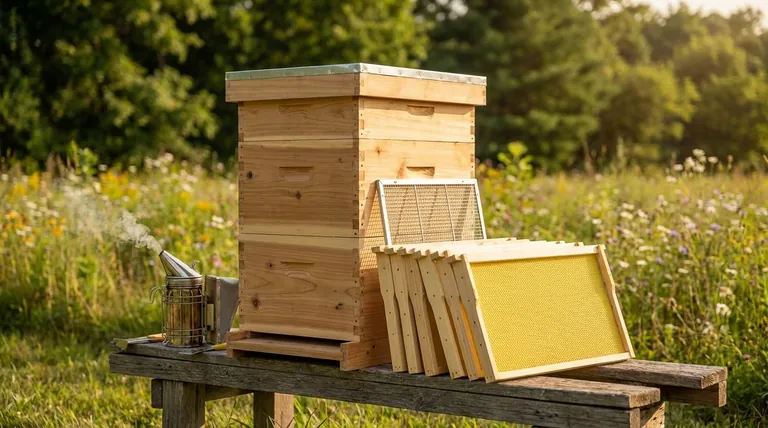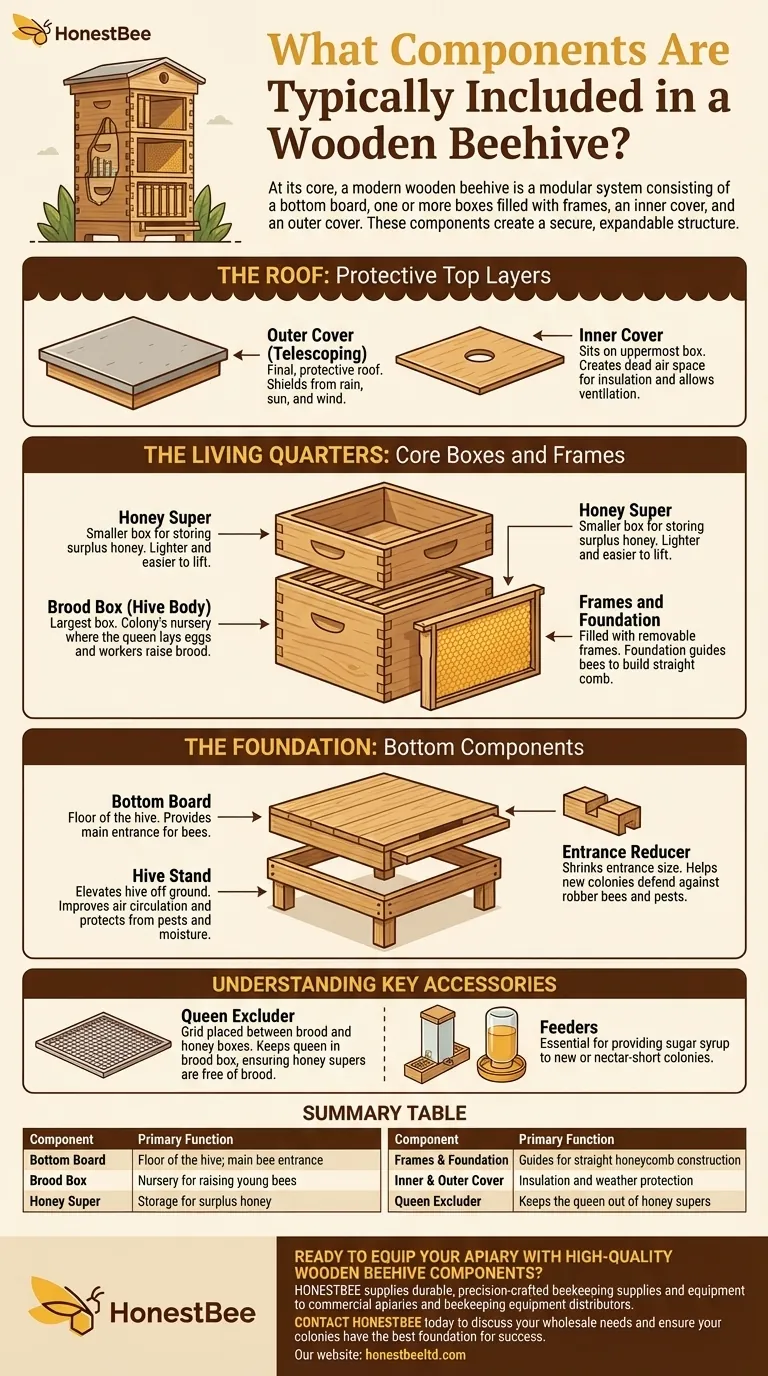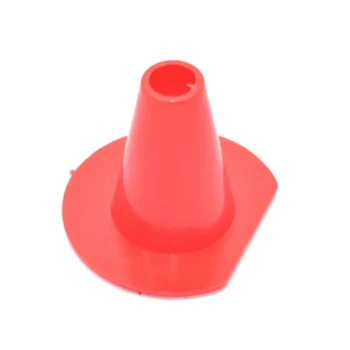At its core, a modern wooden beehive is a modular system consisting of a bottom board, one or more boxes (brood boxes and honey supers) filled with frames, an inner cover, and an outer cover. These components create a secure, expandable structure that mimics a bee colony's natural home while allowing for inspection and honey harvesting.
The key to understanding a beehive is to see it not as a single box, but as a vertical, expandable apartment building for bees. Each component serves a distinct purpose, working together to support the colony's lifecycle from raising young to storing surplus honey.

The Foundation: Bottom Components
The base of the hive provides stability, ventilation, and a single point of entry for the colony, which is critical for defense.
Hive Stand
A hive stand is an optional but highly recommended base that elevates the entire hive off the ground. This improves air circulation, protects the wooden bottom board from moisture and rot, and makes it more difficult for pests to enter.
Bottom Board
The bottom board serves as the floor of the hive. It can be a solid piece of wood or a screened version (for ventilation and pest monitoring). It provides the main entrance for the bees to come and go.
Entrance Reducer
An entrance reducer is a small, notched block of wood placed at the hive entrance. It's used to shrink the size of the opening, which helps a new or small colony defend itself from robber bees and pests.
The Living Quarters: Core Boxes and Frames
This is the central part of the hive where the colony lives, reproduces, and works. It is designed to be expanded or contracted based on the colony's size and the season.
Brood Box
The brood box (or hive body) is the largest box and forms the lower section of the living quarters. This is the colony's nursery, where the queen bee lays her eggs and the worker bees raise the young (the brood). A hive will have one or two brood boxes.
Honey Super
A honey super is a smaller box placed on top of the brood box. Its sole purpose is for the bees to store surplus honey. Using shallower boxes for honey makes them lighter and much easier to lift when full.
Frames and Foundation
Both brood boxes and honey supers are filled with removable frames. Each frame holds a sheet of foundation, which is typically beeswax or plastic imprinted with a honeycomb pattern. This foundation provides a guide for the bees to build their wax comb perfectly straight, making hive inspections manageable for the beekeeper.
The Roof: Protective Top Layers
The top of the hive must protect the colony from the elements, providing insulation from both heat and cold while allowing for ventilation and feeding access.
Inner Cover
The inner cover sits directly on top of the uppermost box. It creates a dead air space for insulation and has a small opening in the center, which can be used for ventilation or as an access point for a feeder.
Outer Cover
Also known as a telescoping cover, this is the final, protective roof of the beehive. It fits over the inner cover and the top edges of the hive, shielding the colony from rain, sun, and wind.
Understanding Key Accessories
While the components above form a complete hive, certain accessories are used to manage the colony for specific outcomes, like maximizing honey production or ensuring colony health.
The Role of the Queen Excluder
A queen excluder is a flat grid of wire or plastic placed between the brood box and the honey supers. The gaps are large enough for worker bees to pass through but too small for the larger queen. This ensures she only lays eggs in the brood box, keeping the honey supers free of brood and pure for harvesting.
Feeders
Feeders are essential tools for providing sugar syrup to a new colony or helping an established one through a nectar shortage. They come in various styles, from entrance feeders to internal models that sit inside the hive.
Assembling Your Hive for Success
How you configure these components depends on your primary goal as a beekeeper.
- If your primary focus is starting a new colony: Begin with a single brood box on a bottom board, with inner and outer covers. Use an entrance reducer to help the small colony defend its new home.
- If your primary focus is honey production: Place a queen excluder on top of your established brood box(es) and add honey supers as the colony fills them with honey.
- If your primary focus is overwintering a strong colony: Ensure the hive consists of two deep brood boxes, giving the bees ample space and honey stores to survive the cold months.
Ultimately, each part of the beehive is a tool designed to support a healthy, productive colony.
Summary Table:
| Component | Primary Function |
|---|---|
| Bottom Board | Floor of the hive; main bee entrance |
| Brood Box | Nursery for raising young bees |
| Honey Super | Storage for surplus honey |
| Frames & Foundation | Guides for straight honeycomb construction |
| Inner & Outer Cover | Insulation and weather protection |
| Queen Excluder | Keeps the queen out of honey supers |
Ready to equip your apiary with high-quality wooden beehive components?
HONESTBEE supplies durable, precision-crafted beekeeping supplies and equipment to commercial apiaries and beekeeping equipment distributors. Our wholesale-focused operations ensure you get the reliable components you need to build and maintain productive hives.
Contact HONESTBEE today to discuss your wholesale needs and ensure your colonies have the best foundation for success.
Visual Guide

Related Products
- Assembled Wooden Bee Frames with Beeswax Foundation Ready to Use by HONESTBEE
- Langstroth Bee Hives Bee Keeping Box for Beginners Beekeeping
- Wholesales Dadant Size Wooden Bee Hives for Beekeeping
- Long Langstroth Style Horizontal Top Bar Hive for Wholesale
- Solid Bottom Board Australian Pine Wood Langstroth Bottom Board for Wholesale
People Also Ask
- What are the advantages of using wooden beehive frames? Natural, Sustainable, and Bee-Friendly
- How do wooden frames perform during honey extraction? Superior Rigidity for a Smoother Harvest
- What are the main parts of a hive frame? A Guide to Modern Hive Anatomy
- How are Langstroth beehive frames assembled? A Step-by-Step Guide for a Durable Hive
- Can I reuse old frames? A practical guide to saving money and reducing waste



















